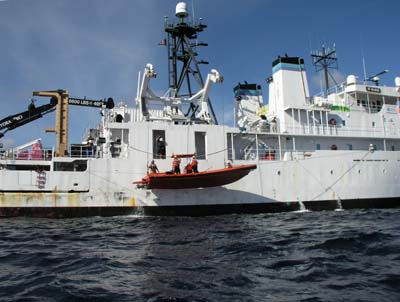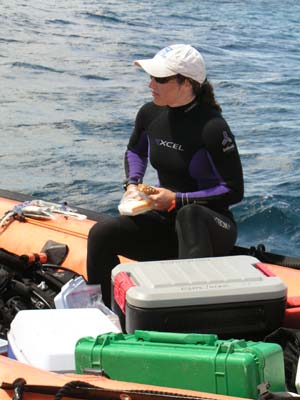|
You
are here: /main/research
expeditions/ 2005 RAMP/9_26_05
Dedication
9/26/05
- Dedication
by
David Nichols, State of Hawaii, DLNR, HIHWNMS

HI-1 being retreived from the water.
We have finished the last of our three days at Pearl and Hermes
Atoll. Pearl and Hermes Atoll is a true atoll that is primarily
underwater and has numerous islets totaling about 80 acres.
There is a huge reef area covering over 194,000 acres. The
atoll was discovered by Westerners in 1822 when two English
whaling ships, the Pearl and the Hermes, wrecked on the reef
during a storm. The actual wreck site of these whaling ships
was located last year by a team from NOAA as they collected
marine debris (derelict fishing gear) around the atoll.
The
atoll has the highest standing stock of fish and the highest
number of fish species in the NWHI. There are species of angelfish
here that are hardly ever seen in the Main Hawaiian Islands
(MHI), such as the masked angelfish and the Japanese angelfish.
The
next stop for the NOAA Ship Hi`ialakai is right next door
at Midway Atoll. The scientists and crew are looking forward
to spending some time on land (though it will only be a few
hours). On our way there the vessel is doing a little benthic
mapping in an area known on nautical charts as Gambia Shoal.
According to the charts this is a large pinnacle that comes
to within 14 fathoms of the surface (from a depth of 2450
fathoms).
The
onboard laboratory is packed full of scientists this evening
all trying to organize their data and specimens before starting
again tomorrow morning in the waters around Midway. The invertebrate
rapid ecological assessment (REA) divers, Scott Godwin and
Holly Bolick of Bishop Museum are busy preserving samples
of small crabs, snails and other assorted invertebrates. Iliana
Baums of the Hawaii Institute of Marine Biology (HIMB) is
also preserving and cataloguing specimens that will help characterize
genetic diversity. Jennifer Salerno (HIMB) is busy filtering
bacteria from seawater samples. Coral REA divers Greta Aeby
(DLNR) and Fenny Cox (HIMB) are busy collecting tissue samples
from diseased surgeonfish for later analysis. Fish biologist,
Matt Craig (HIMB) is removing pectoral fins from collected
fish for later DNA analysis, and chief scientist Randy Kosaki
removes tissue samples from the same fish for stable carbon
isotope analysis. Phycology (algae) REA diver Cheryl Squair
(University of Hawaii) is busy identifying the species of
a small red algae sample. Shark biologists Carl Meyer (HIMB)
and Yannis Papastamatiou (HIMB) are both repairing longlines
that will be used tomorrow to catch sharks and ulua around
the atoll.

Invertebrate
biologist, Iliana Baums from the Hawaii Institute of Marine
Biology takes a brief lunch break aboard the HI-6.
The
dry (computer) lab is also busy with scientists entering the
day’s data into the computer. Fish REA divers, Darla
White (UH), Paula Ayotte (UH) and Kosta Stamoulis (DLNR) are
entering their data on fish species composition and abundance.
Phycology REA diver, Rich Osada (DLNR) is also in the dry
lab busy entering the days dive information into the computer.
This
is a routine that seems to be repeated every day. All these
people are in or on the water from the time the small boats
are launched (near 7:30 am) until they are “picked”
from the water (around 4:30 pm). Most of these teams of divers
make three dives per day. They come back water-logged with
data and samples that need to be either analyzed immediately
or prepared for later more intricate work. Many of these scientists
are working well after 10:00 in the evening but are always
awake and ready for more the following morning. Dedication!
Return
to Expedition main page
|